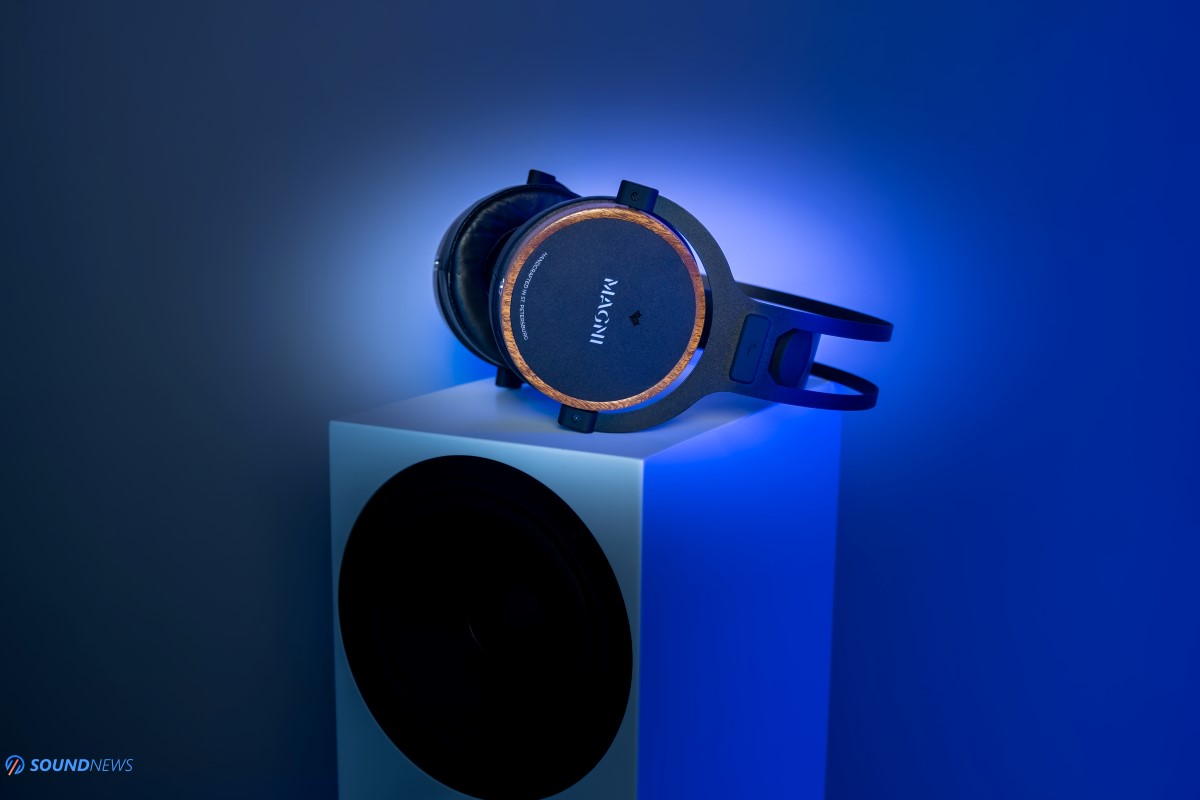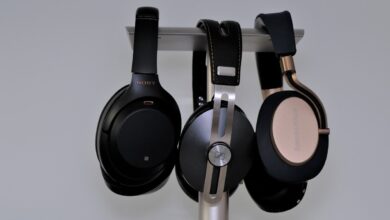Kennerton Magni In-Depth Review
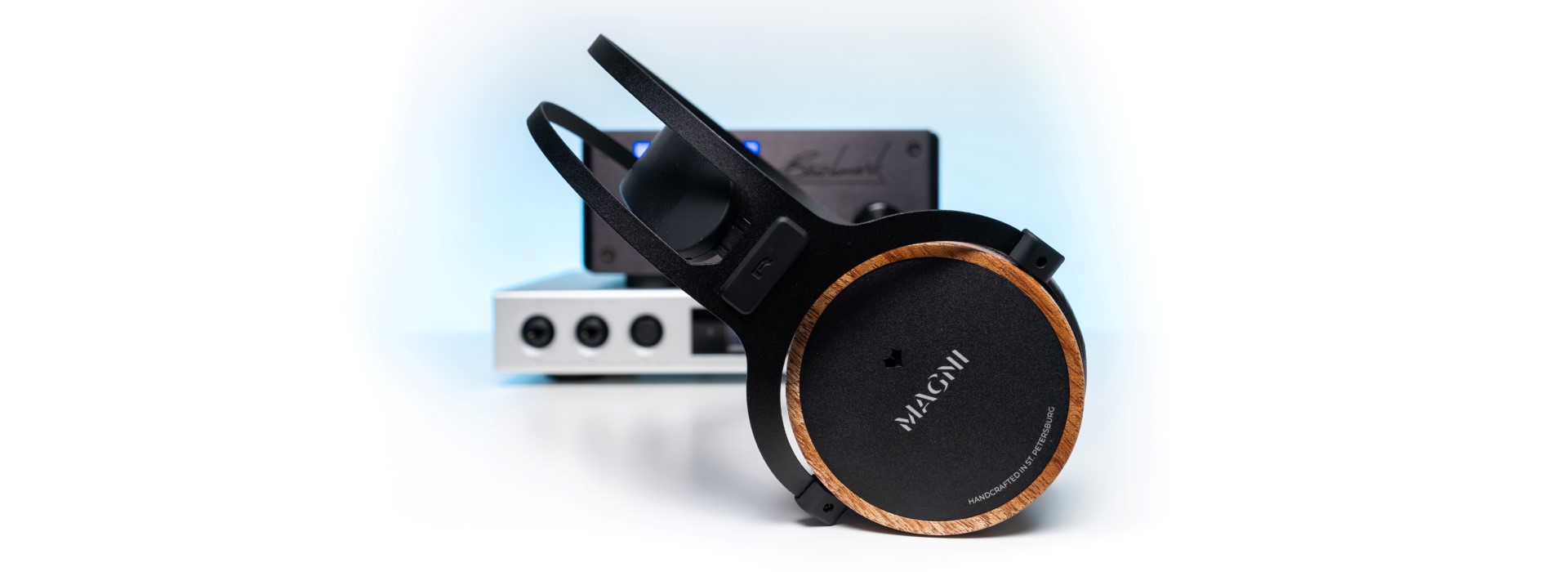
My Video Review:
I’m going to confess, besides Audeze and Meze Audio headphones, there is another headphone brand that I always looked with wolf eyes at. I personally love hand-made craftsmanship, the feel and the smell of such products is unmistakable, there is some kind of pride in owning a handmade product, as you can feel the work that came from the heart and the care that went into making them. Of course, I am about Kennerton Audio Equipment headphones that are looking incredibly gorgeous and unique.
I am also going to confess that I’m a huge Norse mythology fan. You might find in a lot of my reviews mentions about the all-knowing Odin (my favorite mythological being) like “Thanks Odin!” or when I’m describing transient response of a headphone or speaker, I might use the “Thor’s hammer like punch and impact” when something truly excites me to the core. It so happens that Kennerton are making hand-made products with lots of love and care and they are also fascinated about the Norse mythology like I am. How could I not be interested in trying their headphones? I needed to meet them personally.
As you all know, there are multiple spin-offs in the audio business as luxury sub-brands of their parent companies: iFi Audio > Abbingdon Music Research (AMR), Audiobyte > Rockna, Anthem > Paradigm, iRiver > Astell&Kern, Lake People > Violectric, Meitner > EMM Labs, Ruark Acoustics > Vita Audio, Jade Audio > FiiO Electronics and the list goes on and on. In audio it happened so many times and this is exactly what Fischer Audio Engineering did in 2009 when they decided to up their game with something a lot more special, better sounding but more expensive as well. Kennerton Audio Equipment was born, releasing only state-of-the-art products and even trickling down technology from their higher-end headphones into their most affordable ones. The headphone that I will be testing today is exactly that kind of headphone, it is quite affordable in terms of price, but still carries the same handcrafted feel, the same high-quality materials and great sonics of their higher-end models. Today I will be writing about the son of Thor: Magni – that Kennerton impersonated with this headphone.
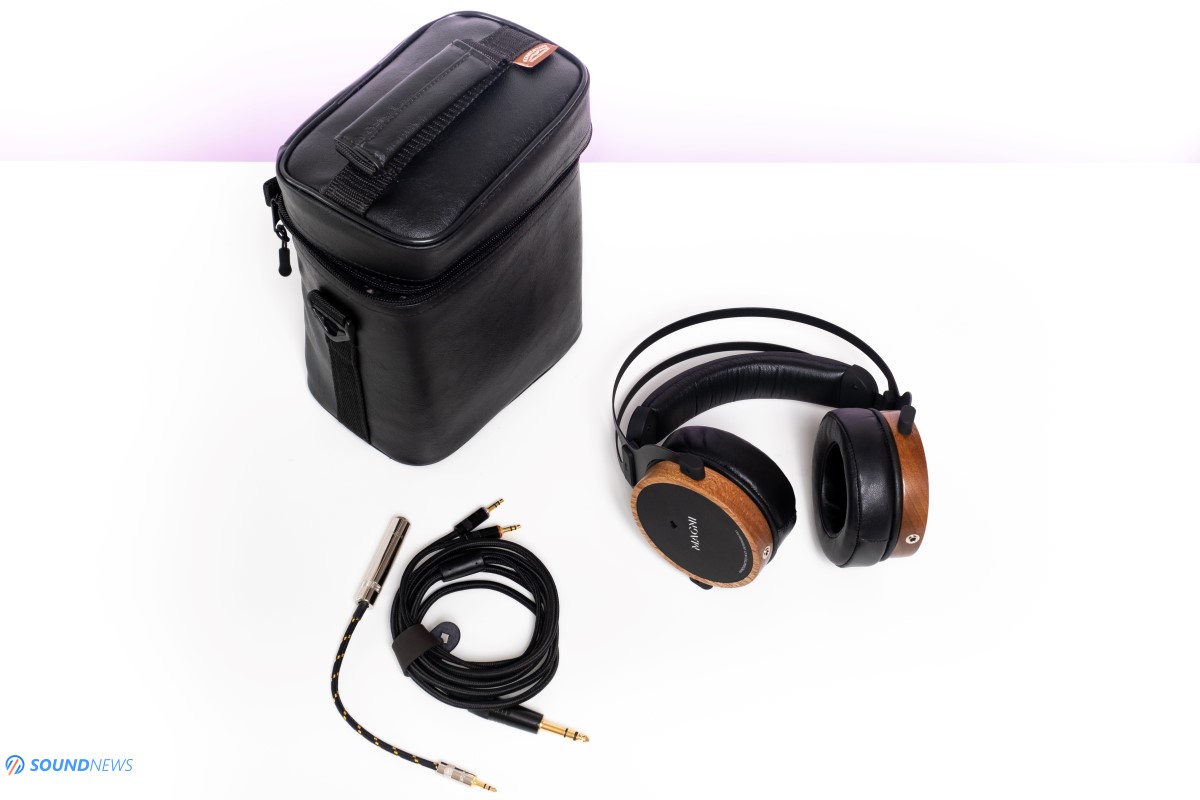
Unboxing Experience
Upon receiving the package, I didn’t know what to expect as I’ve never seen a Kennerton headphone up to this point and my close friends never tested one as well. Even on the card-board box I was reminded that these are handcrafted headphones, proudly made in the Window to the West – Saint Petersburg city. Inside that box, I was surprised to find a high-quality eco-leather shoulder bag stitched with Kennerton Logo. The bag is really thick and it’s padded with some kind of hardened foam for protection. I am not a bag person myself, I never was, but I do find its build quality and its dimensions spot on, its neither too obvious and nor too big to be taken in short or long trips. Simply put, this is one of the nicest headphone bags I’ve experienced so far and I wish more headphone companies would go with a usable transportable bag, instead with some kind of wooden box for display. Erzetich, Sennheiser and Hifiman headphones should take notes on how to think outside the box, on how to provide an excellent unboxing experience, plus a useable transportable bag.
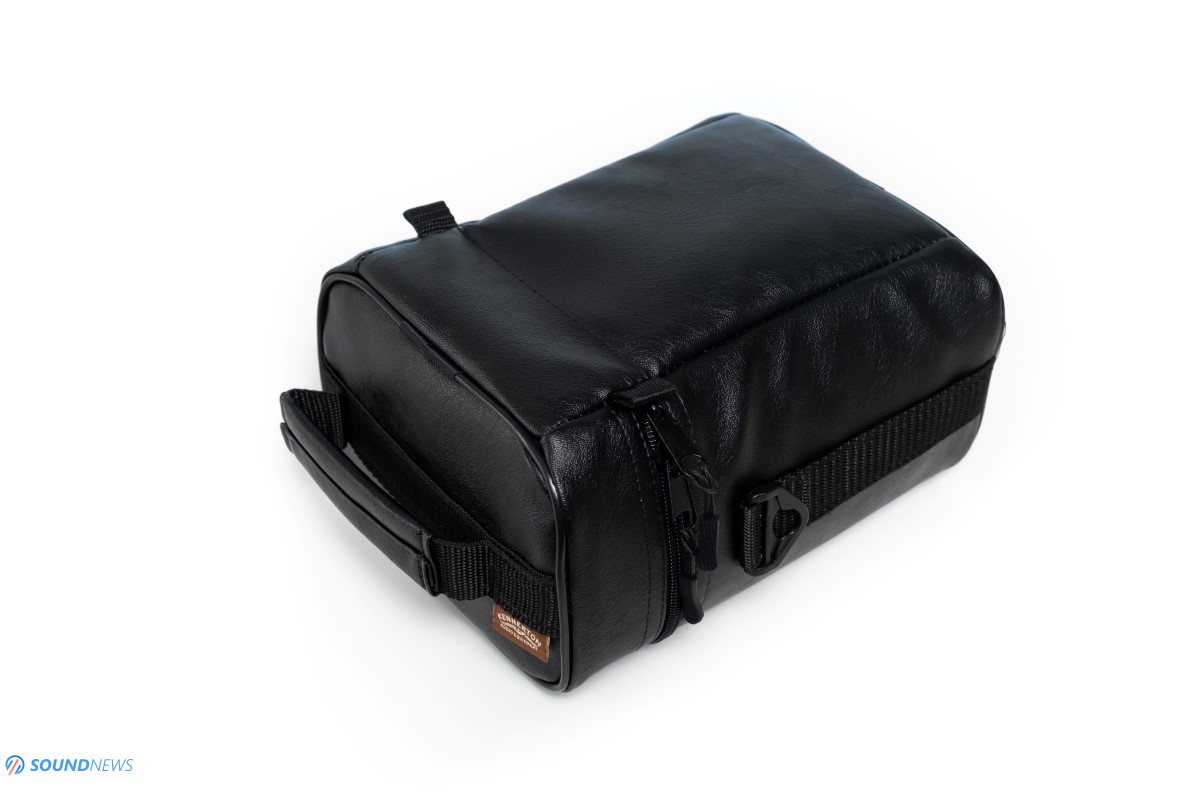
Upon opening the bag, I’ve felt a strong smell of wood coming from within, I’ve picked the Magni, I inspected them and I’ve felt the care that went into making them – a truly marvelous headphone build. Unlike other hand-crafted headphones that could have some marks on them, due to human intervention, Magni was looking perfect, without any marks, scratches, stains and so on.
Besides headphones themselves, inside that bag you will also find a detachable 6.35mm (1/4”) to 3.5mm (1/8”) cable and a small adapter that makes them compatible with portable audio sources. Both cables are also hand-made from high-quality materials. This is one of the nicest stock cables I’ve seen on any headphones at any price level. It puts to shame the stock cables from Erzetich, Quad, Hifiman, Sennheiser and even Audeze. The cable is slightly thicker than usual and this part I like the most because it should resist a lot of use and abuse and we all hate when a cable stops working the moment you want to enjoy your favorite tunes. At the bottom of the card-board box sits an envelope with a short user manual and with a Warranty Statement that is being stamped and signed by the person that inspected them for Quality Assurance.
Even without listening to them, I am already feeling the care that went into making a long-lasting product stored in a well-protected bag. Kennerton was not joking when they mentioned having some of the highest quality materials, offering the best service, making headphones designed by audiophiles for audiophiles.
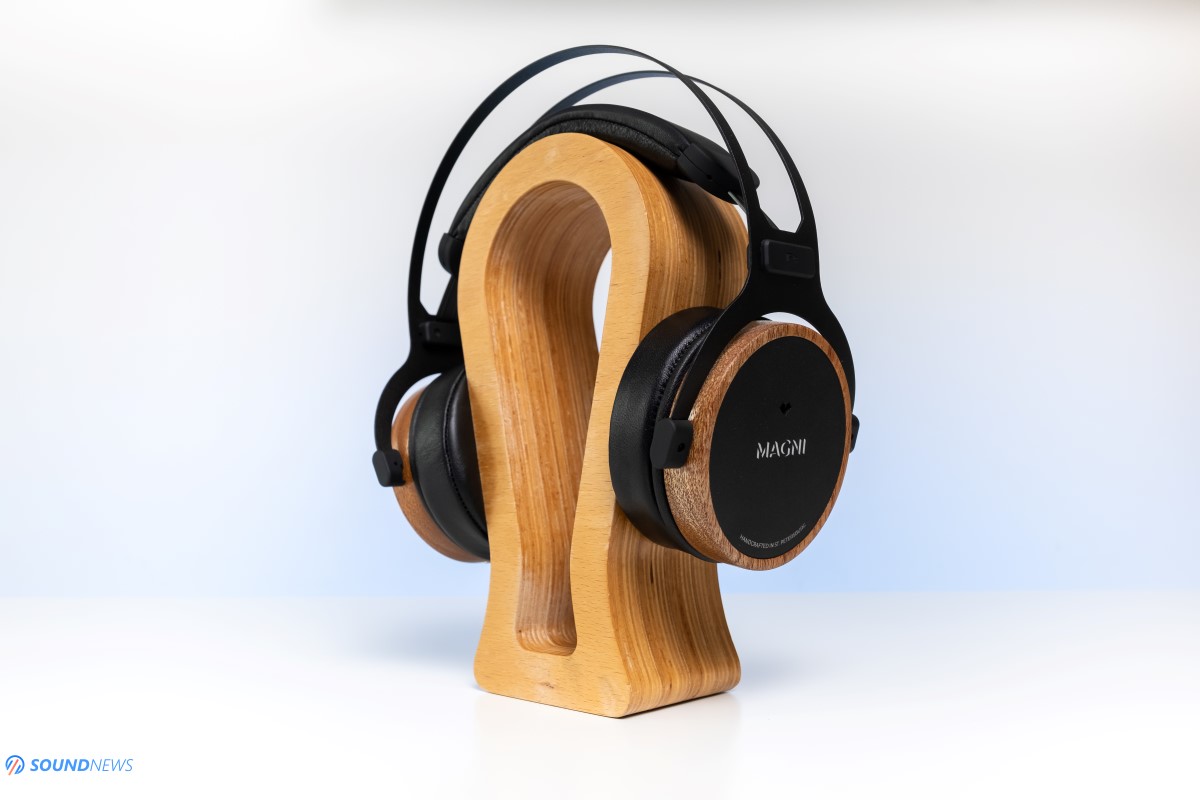
Build Quality & Looks
Besides offering a unique and modern look, Kennerton wanted to feel completely different to other headphone brands and that is precisely why every Kennerton headphone is a build to order. If some headphone brands can make you choose between leather and leather-free earpads, Premium or Pro headbands, Kennerton lets you choose the custom wood-cups that suits you better.
You can have your Magani cups made out of Zebrano, Oak, Lignum Vitae & Ash, Golden Pear & Elm, Dark Ash, Bog Oak, Acajou, Palisander. If you would like to have an extra special one, Kennerton is offering Limited Editions with combined exotic woods and they have another one called Magni OLE (Oleg Lohnes Therapeutikum) edition, specially designed for Germany, Austria and Switzerland residents. Be prepared to pay some extra pennies for a Limited-Edition pair, as when they are gone, they are gone forever.
My particular pair is having Palisander wooden cups that have an interesting porous texture and a really nice smell. Palisander is a hardened wood so don’t worry putting them on your table with cups touching it, I’ve done that multiple times and I can’t spot any marks on them.
The headphone structure is entirely made out of metal, sanded with matte black paint that should withstand the test of time really nicely. The headband really stands out as it automatically adjusts to your head size and is putting little to no pressure around the ear or on top of the head. I’m using the Audeze LCD-4 sometimes even 3-hours in a row and compared to that one, Magni are simply featherweight when I put them on. Thanks to lots of padding on the headband and to their lightweight construction, I can actually wear them for as long as I want without feeling any pain whatsoever.
In terms of comfort, Magni are scoring top-points and it is currently one of the most comfortable headphones I have used and from my stable is it no.2 headphone in terms of comfort, no.1 being the Hifiman Arya.
Other important stuff to mention is that ear-pads are user removable, it is very important to me as I use headphones very often, they are really soft to the touch, filled with some kind of memory-foam. They are made out of real-leather, so you can be sure that they will not peel off as some earpads are doing. The head-band is wrapped with Eco-leather with a Kennerton logo printed on it, that one also has some extra padding at the side that touches the top of the head.
Magni weights approximatively 440 grams (or about a pound) and compared to the heavy weight champions of this industry as Audeze LCD-4 at 735 grams, or Erzetich Phobos at 690 grams, Magni feels like a lighter weight lifter that could stay on your head for hours and hours without bothering you too much.
In terms of build quality, choice of materials and comfort I can only congratulate the Kennerton team by taking extra measures in having all those checked with flying colors. In this regard, I don’t have any complaints and I wish more companies would put a bigger importance to materials and comfort.
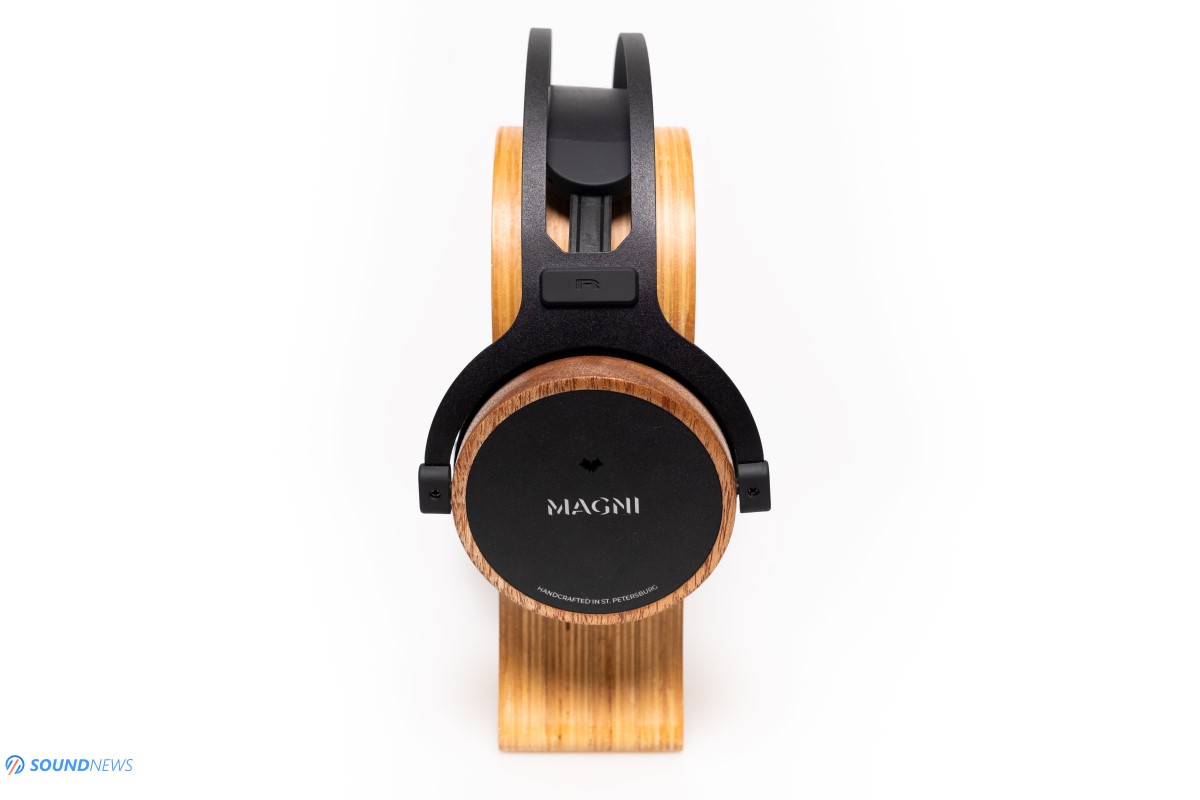
Technology Inside
Instead of a planar-magnetic driver that can be found in their high-end Wodan, Odin, Thekk and Thror headphones, Magni is relying on a 50mm dynamic driver, it is their mid-range model so the dynamic driver shouldn’t come as a surprise. However, if you are closely inspecting the Magni, you can spot the same build and high-quality materials the higher-end models are having, only the wood cups and hinge mechanisms are slightly different.
Magni is a closed-back headphone and sincerely a lot of time has passed since a closed back-headphone landed on my table. The latest ones that I have listened to were the Sennheiser HD820, The Fostex TH-900 Mk2 and the Drop TR-X00 Purpleheart. I’m more of an open back headphone listener, but I’m open minded and I’m quite sure there are several nice sounding closed-back headphones out there as well.
What is standing out from the start in terms of technology is the use of graphene for the driver material. Graphene has a special set of properties which sets it apart from other alltropes of carbon. It is about 300 stronger than regular steel, but its density is dramatically lower than that of steel, making it extremely hard to damage but easy to move when applying a magnetic force.

As far as I know, Kennerton are one of the first adopters of such drivers, there are other manufacturers that also released headphones with such drivers, and some are being developed right now. I’m happy to see it used more often, as graphene has a great potential as laws of physics will never lie. Creating a pure graphene membrane with current technology is time-consuming and very costly with very low yield rates and as a direct result Kennerton went with a hybrid membrane made of mylar that is powder coated with graphene using a thermal method. In return, the classical dynamic mylar based driver is significantly improved, having a much better strength, meaning a higher SPL can be applied to it without the fear of damaging it. It also increased its rigidity and lowered the unwanted vibrations to all time low. Kennerton added an ultra-light aluminum voice coil (CCAW) that was covered with a thin layer of copper to increase its electric conductivity.
Besides a high-performance driver, a powerful magnetic force will be needed to push it back and forth and create a nice impact, increasing the overall speed of the driver. Kennerton used a much bigger magnet structure compared to its competitors to increase the magnetic force that is being applied to the driver. All of this combined should offer a wider dynamic range, a better kick and impact into eardrums with minimal loss in terms of details and transparency.
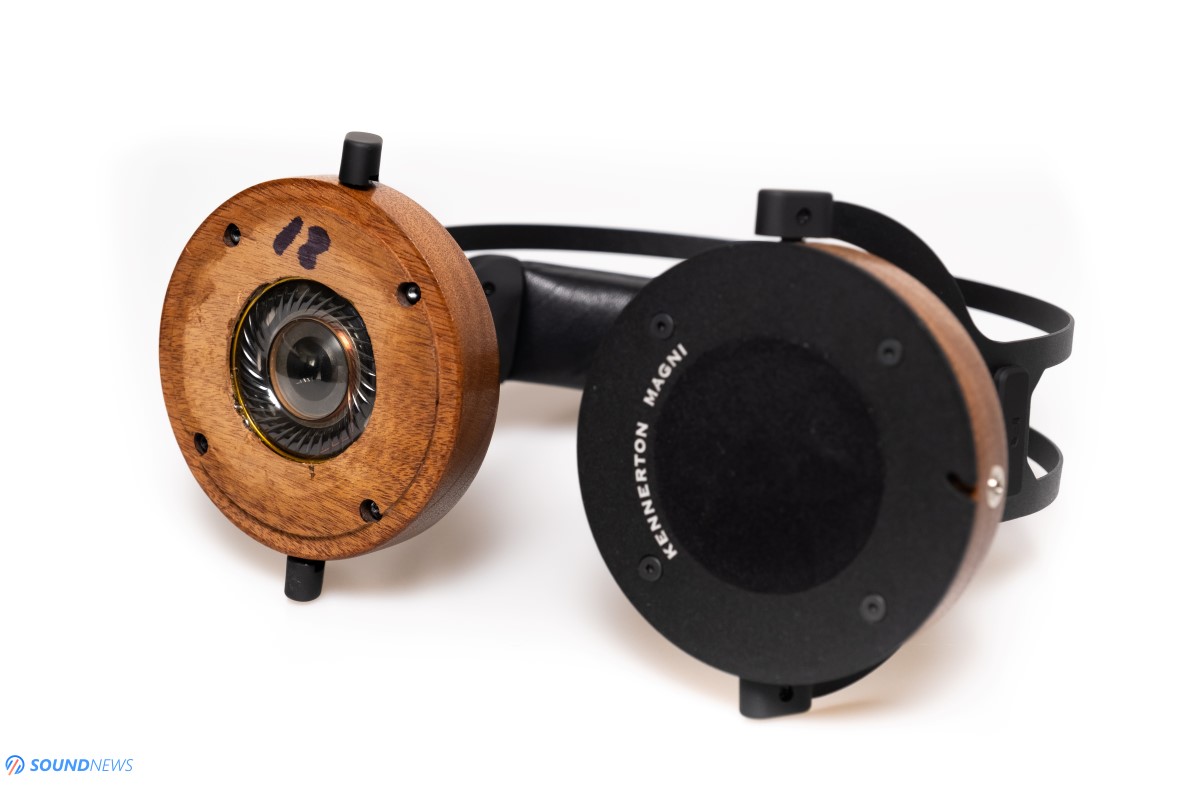
Do note that I am testing the latest revision of Magni, which currently sits at revision number 3. The last version was released few months ago and with it Kennerton made huge advancements in wood cup design. Instead of polycarbonate rings to which the drivers are attached to the cups, they are now made out of solid wood carved on the wooden cup itself, so the resonance of the driver and of the cup is as low as possible.
There is a huge challenge designing good sounding and measuring closed-back headphones, it is by orders of magnitude harder to develop compared to open-back headphones. With open-backs you simply put a grille and a thin layer of mesh on the outer side of the driver and missions is complete. However, with closed-backs you are fighting with much higher resonance of the earcups, with sound pressure behind the driver that can spread back to the listener, increasing the total harmonic distortion. You need to have a perfect balance in the dampening material and you need to balance how close or open it should sound. With Magni, I do see all the extra effort that was made from Magni 1 to Magni 3 to have a much better headphone at a very reasonable price point. Here is a photo that that shows exactly what is the difference between all versions of Magni in terms of cup and driver design.
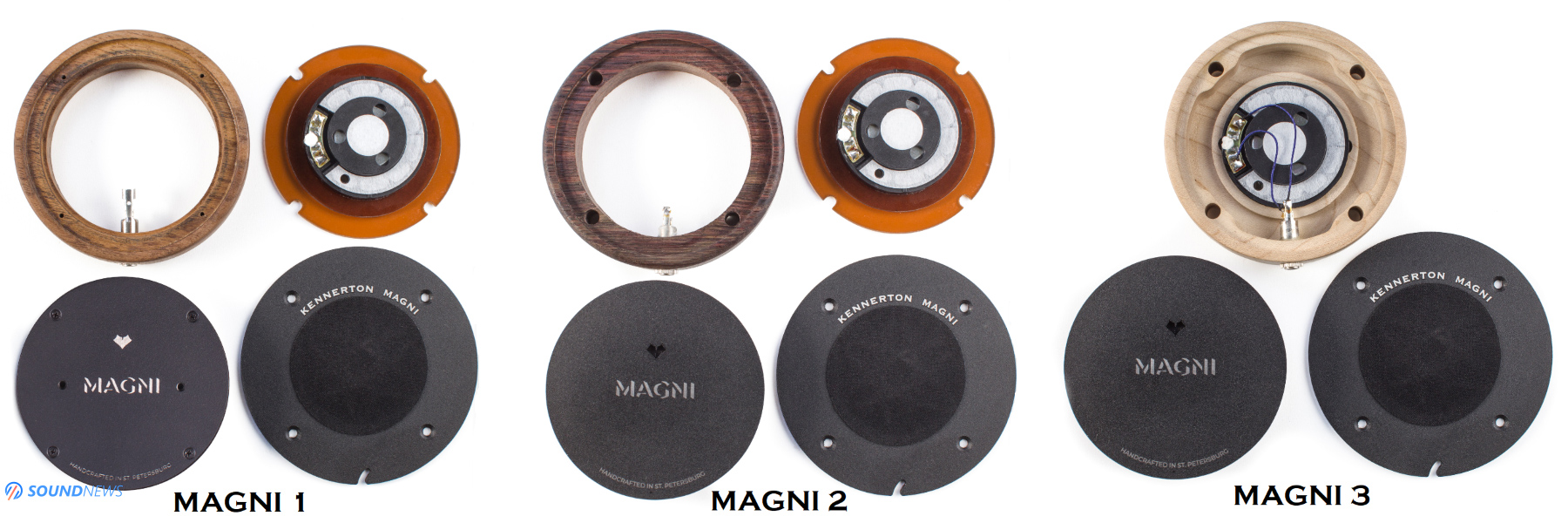
OK my friends, I’m thirsty for some music so let’s hit some eardrums.
Sound Performance
I. Preliminary Impressions
After reading a lot about everything that makes them work, plus the improvements of the latest revisions, as you might expect, I was quite excited when I received them. I started a long listening session immediately even without any kind of burn-in. At first, I was reminded that this is a closed-back headphone thanks to its robust and hefty bass response and to everything that is tied to it. Low-end made its presence felt immediately down then jaw bone. In terms of lowest registers, Magni offers an impressive feat for the ears by offering a heftier quantity, but a lot of quality in the process as well. Secondly, I’ve felt a heavier midrange, that was fuller in its tonality and made the all the voices in a crowded track standing out from the rest. The spotlights would be mostly put on the lows and mid-tones that shined brighter than the rest. Treble information was a bit shy at first, rounding a bit the top octave but making everything smooth and easy going. I’ve felt all that only with few hours of play and I’ve got a feeling that these should improve considerably the following days. 24-hours later and treble opened a bit and finally I was able to discern smaller details in my usual test tracks. Finally, there was a bit of bite up-top that would increase the excitement levels especially when listening to some treble oriented music. Still, the smoother approach, that liquidity and note-binding that I’ve felt from the start remained intact.
Another thing that stood out completely was a really heavy thump into my eardrums, that would make my body move to the rhythm of the music. I don’t know why, but when sometimes truly excites me and when my strict rules in terms of transient response are met, then I would start tapping my feet and will slowly bang my head.
There isn’t a single doubt in my mind that Magni are some enjoyable headphones, they were developed mostly towards a fun musical experience and probably not so much for analyzing your music with a magnifying glass. There is some kind of charm in this one that usual dynamic headphones are not having, it is difficult putting a finger on what exactly makes it different. Some might say it is the speed of the driver and the impact that follows, other might think it is naturalness that Magni possesses in the long run, or that liquidity that is bonding all the notes together, but I think it is all of the above that makes Magni…well…Magni.
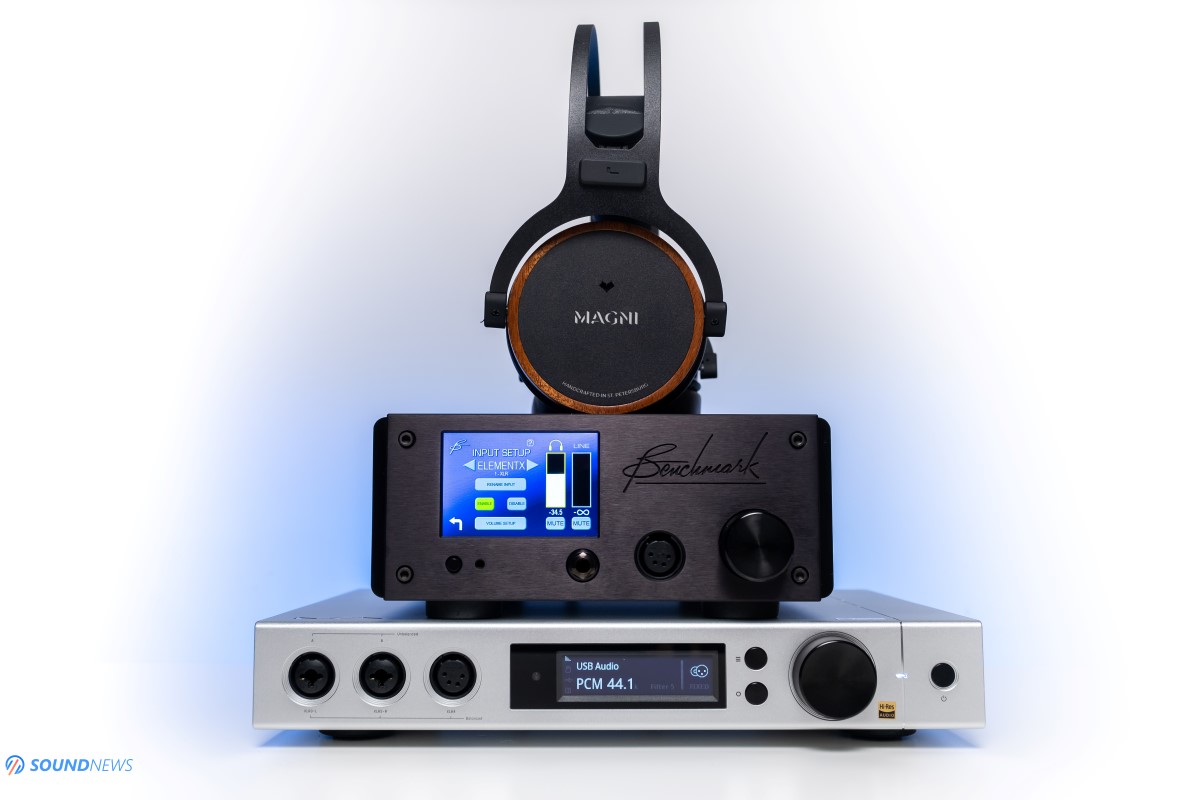
II. Power Requirements
There is something special that I want to mention about the Kennerton Magni: its incredibly high sensitivity! Kennerton mentions it at a super high 114 dB per 1mW of power, making it one of the easiest to drive desktop dynamic headphones I know of. It’s a combination of multiple factors, the low impedance of 33 Ohms is part of that equation and probably the thin graphene membrane also left a mark on the sensitivity. I needed to test that for myself to believe with my own ears and indeed compared to the rest of desktop headphones that I am using daily, Magni is the easiest to drive and with it I always need to double-check the volume level, as Magni is becoming very loud and fast with all of my desktop headphone amps.
Compared to Hifiman Arya it is by about 13 dB more efficient according to the Benchmark HPA4 and MiniDSP EARS, by about 14 dB more efficient than Audeze LCD-4 and the list continues. If you ever tested a Meze 99 Classics or a pair of Sennheiser Momentum 2 over-ears then you should know that Magni is only by 2 dB harder to drive compared to those portable over-ear headphones. This is a very big deal, since you can drive the Magni at its maximum potential with low powered sources such as Hi-Fi portable music players and with smaller DAC + headphone amp units. Even those small dongles like Audioquest Dragonfly, Meridian Explorer, Cambridge DACmagic XS, Audioengine D3 and many others are more than capable of driving the Magni to very loud levels or dare I say to their maximum potential.
I now get it, why they included a transportable bag with this one, as almost any headphone jack can drive them adequately and most of the Hi-Fi portable DAPs will drive them fully. I personally love the sound of the Audeze LCD-4, but I am not liking their sensitivity that makes them only stationary headphones to be listened at home, not to mention the extra expenses with the big and heavy amplification. If you don’t feel like spending a fortune on high-quality headphone amplification, Kerrnerton Magni might be the ticket to the musical wonderland without breaking the bank.
As beautiful as it looks on the outside, it looks the same on the inside and I’m happy that things as sensitivity, driver materials, voice coils and powerful magnets were not overlooked in a mid-range model like Magni.
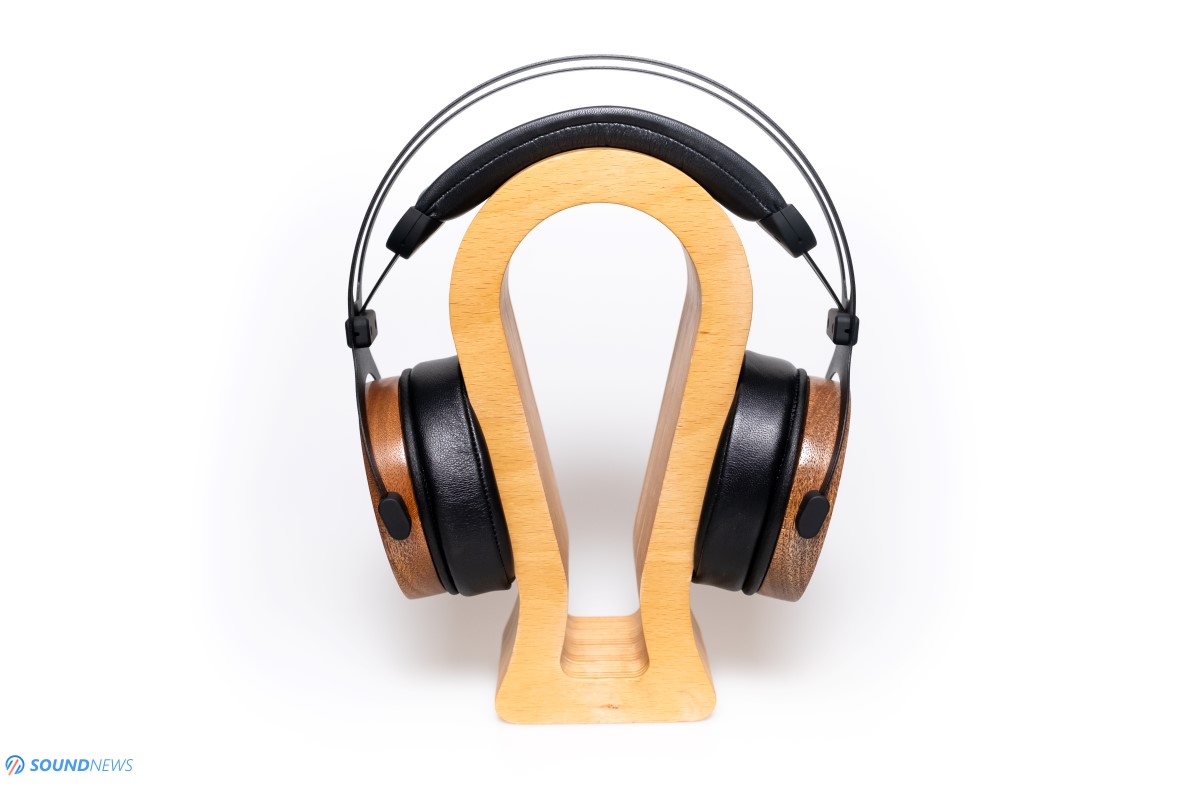
III. Transient Response
One of my favorite things to write about is the speed and the kick of the driver that subsequently increases the dopamine levels in the blood stream and makes us smile and feel good.
I’m glad that Kennerton used this particular name to describe them, it fits them perfectly as indeed, it hits and pounds as the oldest son of Thor. It might not wield the hammer of his father, but it surely has the strength to land some punches when it comes to fast executed notes. I might start my day by listening to some smooth jazz or blues, but there are days when I need to kick-start that engine of mine and when coffee is not doing its job, then some fast tunes will surely wake me up and make me feel energized for the rest of the day. Magni knows how to impress a person that is a lot into fast music spreading across multiple musical genres.
I’m not sure what is at play here, maybe is that huge magnetic force that Kennerton increased in this one, maybe it’s the graphene coating that made the music articulate and hard hitting, maybe the absence of polycarbonate rings decreased the ringing of the cups, or maybe all of the above played a bigger role in achieving a fast transient response that accelerates dynamics almost instantly.
In a headphone of whatever shape or form, the biggest disappointment for me is when I’m experiencing a loose sound, mellow dynamics and slow transient response that simply can’t work half-decent with fast beats. In this regard, Magni sits at the opposite pole, having a good laugh and making fun of those slow and mellow sounding headphones. I said it before and I will say it again: all cars can go slow and having a smooth ride, but not all them can go really fast, accelerate and decelerate in an instant. Same applies to the headphone world and I will always have a much bigger respect for those that can sound fast, snappy, articulate with the right music and electronics.
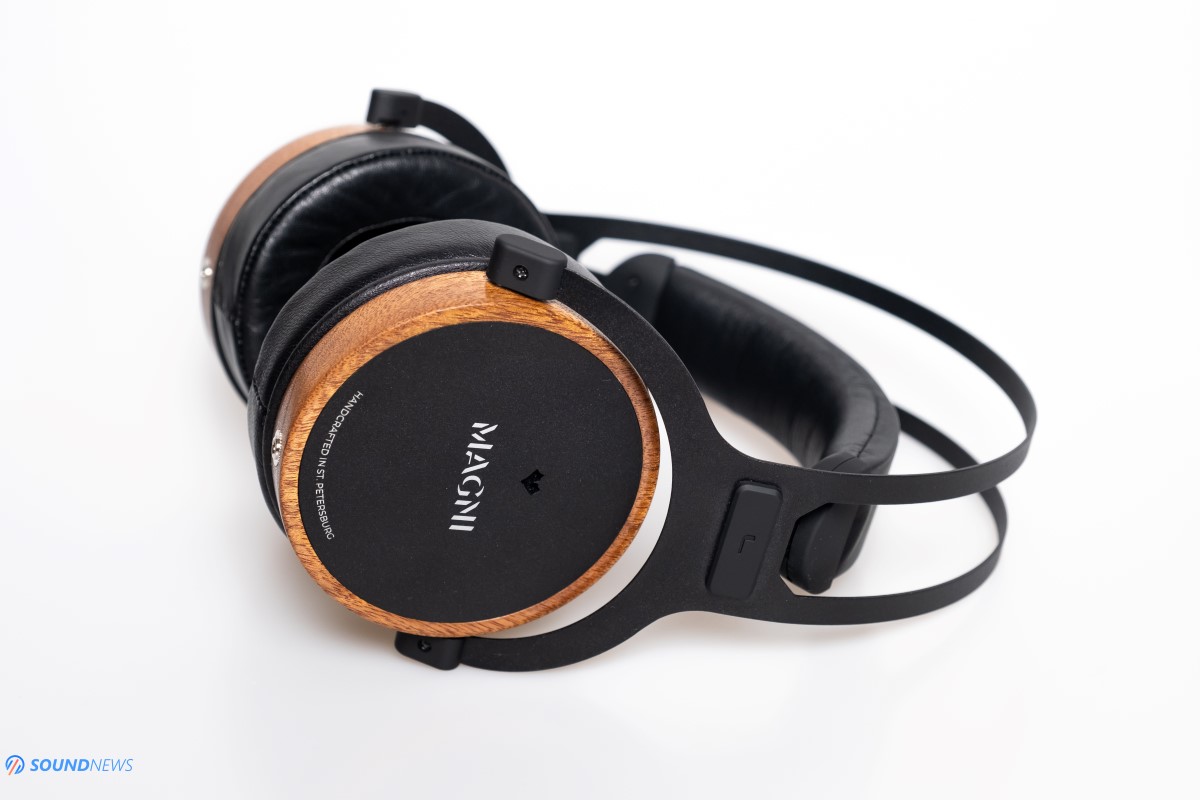
Magni is indeed more about the speed and the slam that follows and if you are into fast and energetic music, then Magni will be right up your alley with its nimble and hard-hitting approach to music reproduction.
I also want to point out that if you are into slow mellow music, then sure enough Magni will calm your spirits, will lower its pace and will add a bit of refinement for a relaxing evening.
It so happens that the legendary album of B.B.King & Eric Clapton – Ride With The King (Tidal / Spotify) was remastered not too long ago and I decided to give it a go on the Magni. Key To The Highway still feels so damn impressive after so many years, it is a smooth ride alright, head started banging immediately, the smoky nature was felt instantly and I simply leaned back and enjoyed every second of it. Magni was able to put me into a relaxed state, I closed my eyes and I was guessing where everybody is located around me. Those two voices played with my imagination exchanging places once a minute or so, those strings carried so much textures and the drums while not hitting super hard, were felt distinct and precise with nice leading edges. Magni reminded me that, if you can go really fast, then you can go slow as well and not the other way around.
The more I listen to Magni in a revealing system, the more I am realizing that Magni is actually among the most fun headphone I’ve listened to in a long time. It reminds me a lot about the Quad ERA-1 that also has a very hard hitting and fun nature, I almost want to call it a sister headphone to the ERA-1, it is still a bit different experience, but not by much.
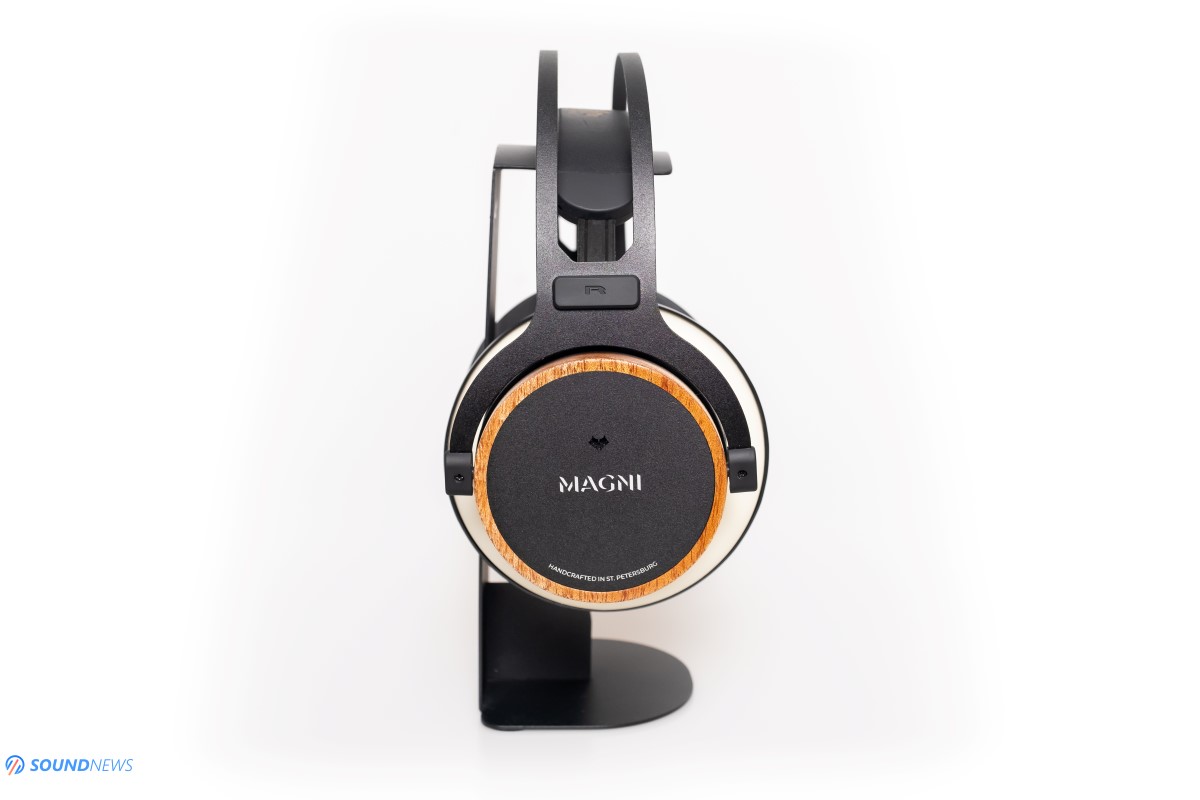
IV. Soundstage & Depth
Proggresive band Long Distance Calling just released their newest album How Do We Want To Live? (Tidal / Spotify) and knowing their past work, I knew this one should impress in terms of depth and stage size on both width and height. Even starting with the first song called Curiosity Pt.1 it already starts playing with pin point location of all the notes around the listener. This record is Ok with loudspeakers, but much better with headphones in my opinion. Even the heart beatings felt more visceral, close and personal, the thump is something else with headphones, I almost want to lower that volume down due the hard-hitting nature of the Magni.
Switch to some cozy jazz recorded in small venues or in a crowded studio and you will be thrown on-stage with the band playing only for you. Magni can sound up-front and personal with some particular music, but it also knows how to expand the stage and decompress it to a much larger scale. When I’m switching back to some open-backs from my stable, I feel that there is more air rushing in, but I still think that in terms of depth and how deep a note could fly, Magni is really up there with open-backs, which is kind of impressive.
The soundstage took a small hit compared to open-back headphones, but that was understandable and that is a natural phenomenon. However, do note that compared to say a Meze 99 Classics or Sennheiser Momentum 2.0 (over-ear) which sounded pretty nice in terms of stage size and depth, Magni is considerably more open and wider on all axes. Magni has a medium to large soundstage size and if a song is recorded in a bigger studio, that will be felt immediately.
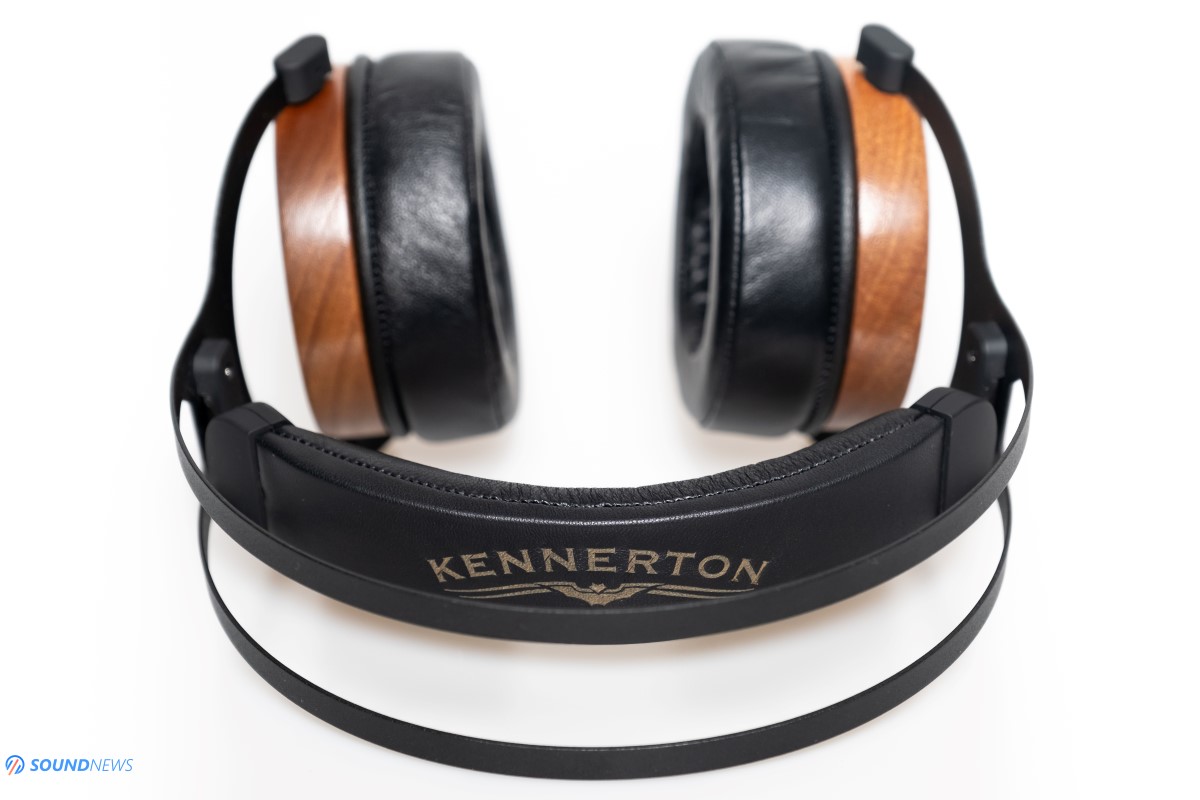
V. Detail Retrieval & Transparency
This is another interesting chapter that I want to cover. Overall, the treble response is a bit rolled-off, especially the highest octaves are less piercing and will carry considerably less sharpness and leading edge, that might make you think it is a less detailed headphone. Those are some clever design decisions that few manufacturers adopted to make you feel there is more “detail” in your tracks. Magni is not doing that, there isn’t a fake sharpness filter applied, it doesn’t attract a lot of attention to the higher regions. As treble, the rest of the frequency response is as hard to balance and maintain a higher degree of detail. I felt multiple layers of bass on some tracks that I know for a life-time, those layers can be felt as pulsating beatings that are rendered only by few headphones from my stable. Even Erzetich Phobos which is a mighty fine headphone, cannot awake those to their fullest. With Magni, I am spotting those and I don’t even need to close my eyes. Probably the latest revision no.3 dropped the total harmonic distortion and resonance to very low levels that makes everything tighter sounding, a lot more controlled, increasing the transparency levels in the process.
To me, Magni is a detailed sounding headphone, it is easily in the same ballpark with most headphones in the $1k price-bracket. I’m spotting a bit more micro-details compared to something like a Sennheiser HD650 and considerably more compared to closed-back design as Sennheiser Momentum 2.0 and Meze 99 Classics. With all that said, do note that Magni doesn’t want to make your music like a big magnifying glass, it lets you choose: do you want to relax and be part of your music, or do want to analyze it with your eyes closed. It is really up to the listener.
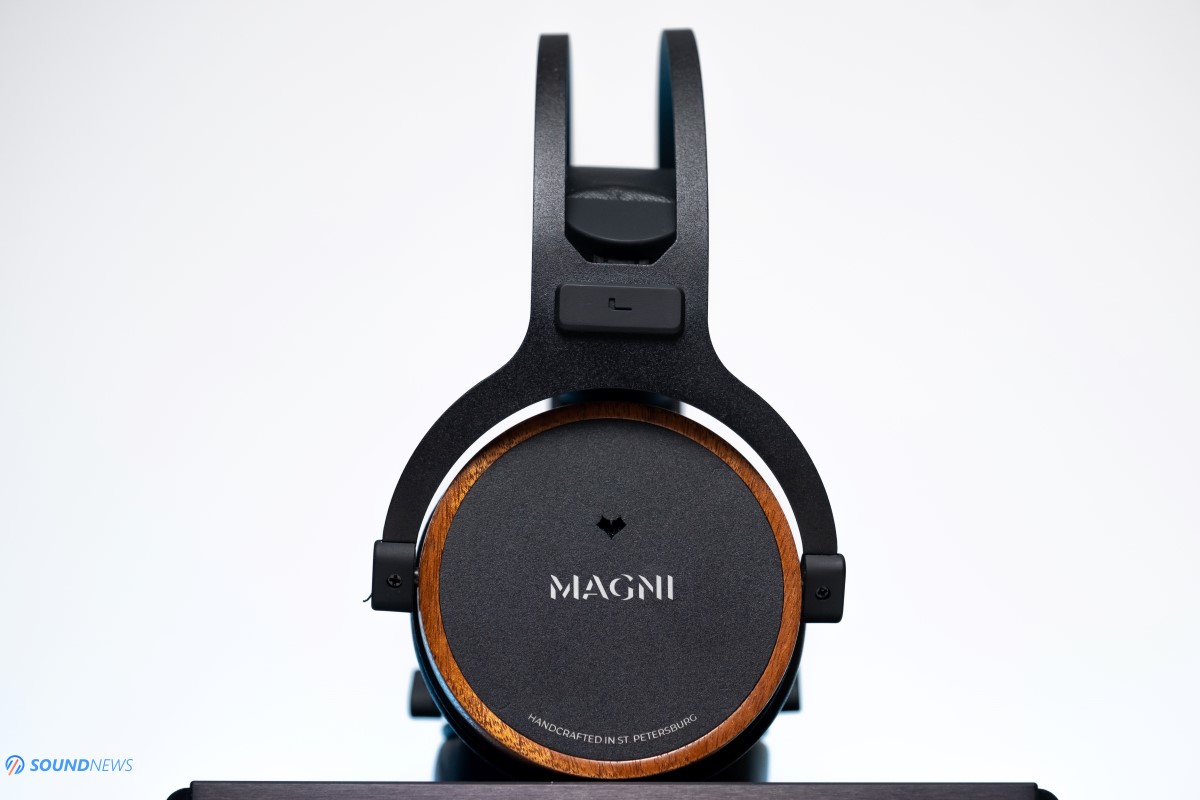
VI. Frequency Response
A. Bass
Magni is not a bass-canon headphone, but it has it boosted a bit, really outlined and it will always turn your attention to this region. One of the nicest things to mention about Magni is that its graphene coated drivers are starting moving even before 20 Hz. If you love your sub-bass, Magni has gobs of information in that region. It is always articulated, it hits hard, there is quite a lot of quantity and quality to it as well. Thanks to its fast response time and speedy presentation, bass actually sounds tight, fast and doesn’t linger way too much as an old subwoofer would do. I’ve thrown everything at this one, I’ve tried some old rave, drum & bass, even some chamber music with lots of organ pipes and contrabass and there is no other way in saying it that Magni simply excels in this area.
Mid-bass is a bit boosted compared to the lowest octaves and makes its appearance a bit more. There is a feeling of warmth while listening to Magni and no matter what you do, it will always carry over from one track to the next one. That warmth and natural decay of the notes is often times a direct result of a really nice midrange presence and deep bass performance. So, if you like to rock-out and hand-bang to your tunes, Magni got that in spades with its full bodied and fun approach to music playback.
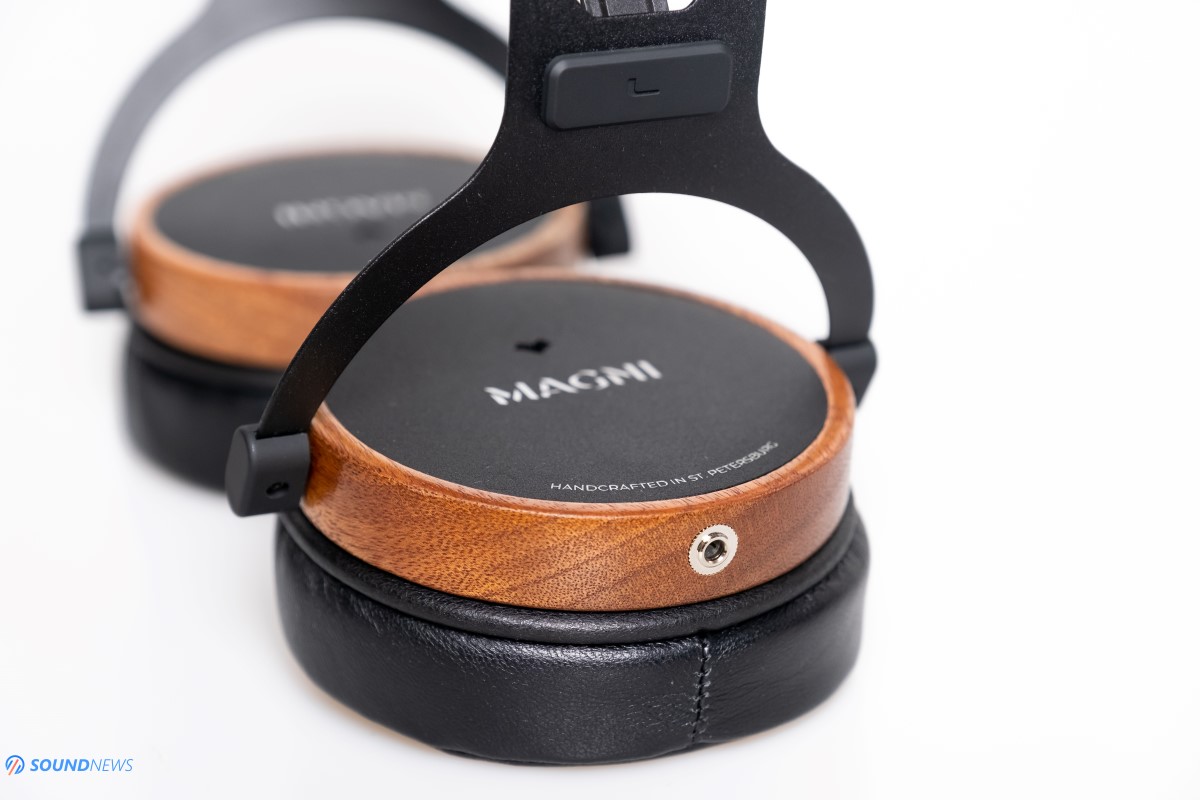
B. Midrange
I consider myself a midrange addict and if this region is rendered badly, everything will sound lifeless and thin to me. Luckily, Magni is anything like that and has a quite bold and thick midrange. I don’t consider it overdone, it is about on the same level with the low and mid bass. It indeed stands-out especially while listening to some blues and rock, it is really something else. When midrange is done right, then I can attribute words as genre master to some audio equipment and Magni would be not far away from that description. I am into all kinds of stuff, from slow and mellow music, to fast tunes, from 100-years old jazz to modern tracks, almost everything is interesting to me (with few exceptions, of course) and I do feel that Magni played everything in an engaging way, in a very natural manner, awakening some really nice dynamics as well. Magni has a full-bodied approach to music playback and that is because it has a high-density type of midrange, it’s thicker in there and makes all those voices and string instruments really stand out from the rest.
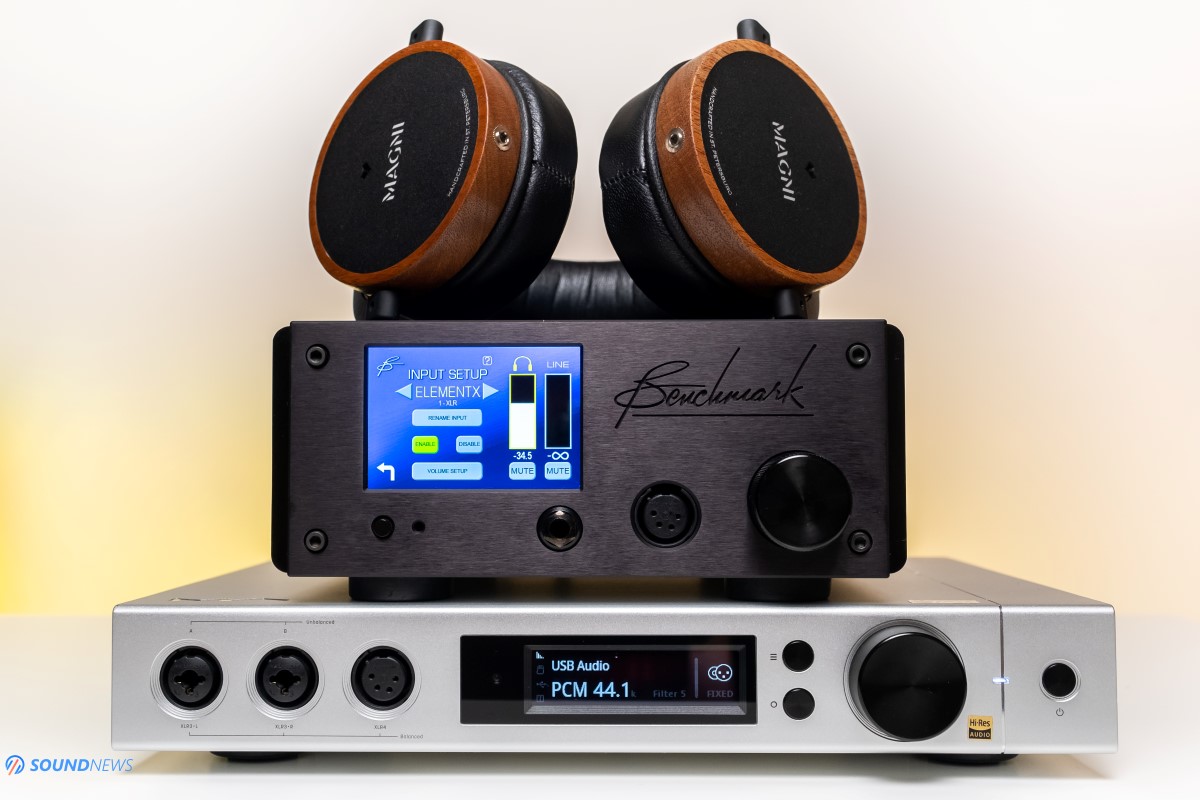
C. Treble
Right off from the start I’ve felt a small decrease in treble intensity in the most sensitive area of our hearing. Somewhere around ~6kHz I felt it less piercing and toned down a bit. It is enough to notice its complete brightness-free and relaxed treble presentation. I want to add that, treble is not smeared by any means, it is not muddy or less clean sounding as the rest of the spectrum. It’s clean, articulate, it has a really nice natural texture all over it. Only its intensity and sound pressure level is tamed to obtain a more relaxed and easy-going nature. Magni offered a non-aggressive and life-like treble response that is very close to that of Audeze LCD-4 – which is currently my favorite headphone.
The upper registers seem to have a gentle roll-off as well, somehow making even bright recordings very manageable and less invasive if you will. If your acoustic chain is a bit hotter sounding up-top, Magni could solve that issue without any changes to your hardware setup.
I’m listening to music for more than a week with Magni on my head and I’ve observed that metallic sharpness of bells and tambourines is not as apparent as it does on Hifiman Arya or Erzetich Phobos, in the long run those two can cause listening fatigue. Magni is both an easy rider and a hard puncher, if I want to rock-out – they will provide some nice transients and If I want to listen to some relaxing music just before bedtime – they will tone down everything for a soothing and calming experience.
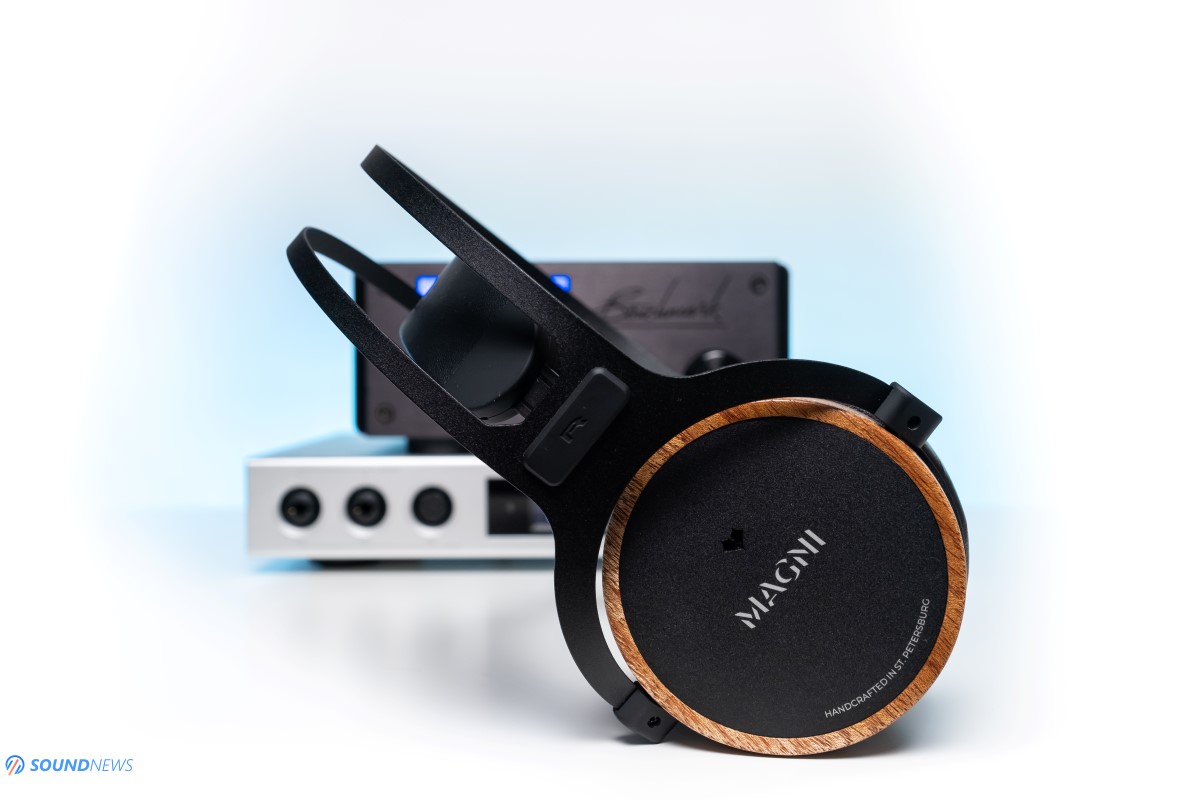
VII. Measurements
After offering my full-blow subjective opinion, it is time to put them under a magnifying glass and see how they perform. It is a closed-back headphone, so I am sure their placement on the measuring rig will drastically alter their frequency response (FR). When it comes to measurements, my best friend is still the Benchmark HPA4 as it is as linear as headphone amplifiers could go and since the Audiobyte HydraVox DAC is singing some beautiful songs for a friend of mine, I resumed at using the Matrix Audio Element X as the main DAC. The measurement rig was the MiniDSP EARS calibrated with HPN (Original Headphone Compensation) files. Do note that MiniDSP EARS is not following any IEC standards, meaning that my readings can’t be used as reference measurements or anything like that, I’m doing them only to get a general idea about their sound signature.
The first issue that I encountered is that the leather pads are staying exactly on top of metal screws around the silicon ears of the MiniDSP EARS system, thus breaking the seal and recording a non-representative frequency response. Here is an example when the seal is broken and as you can see the sub-bass sees a huge roll-off which is not what I’m hearing. Do note that if you are using glasses the same story could repeat itself and sub-bass could be lowered substantially.
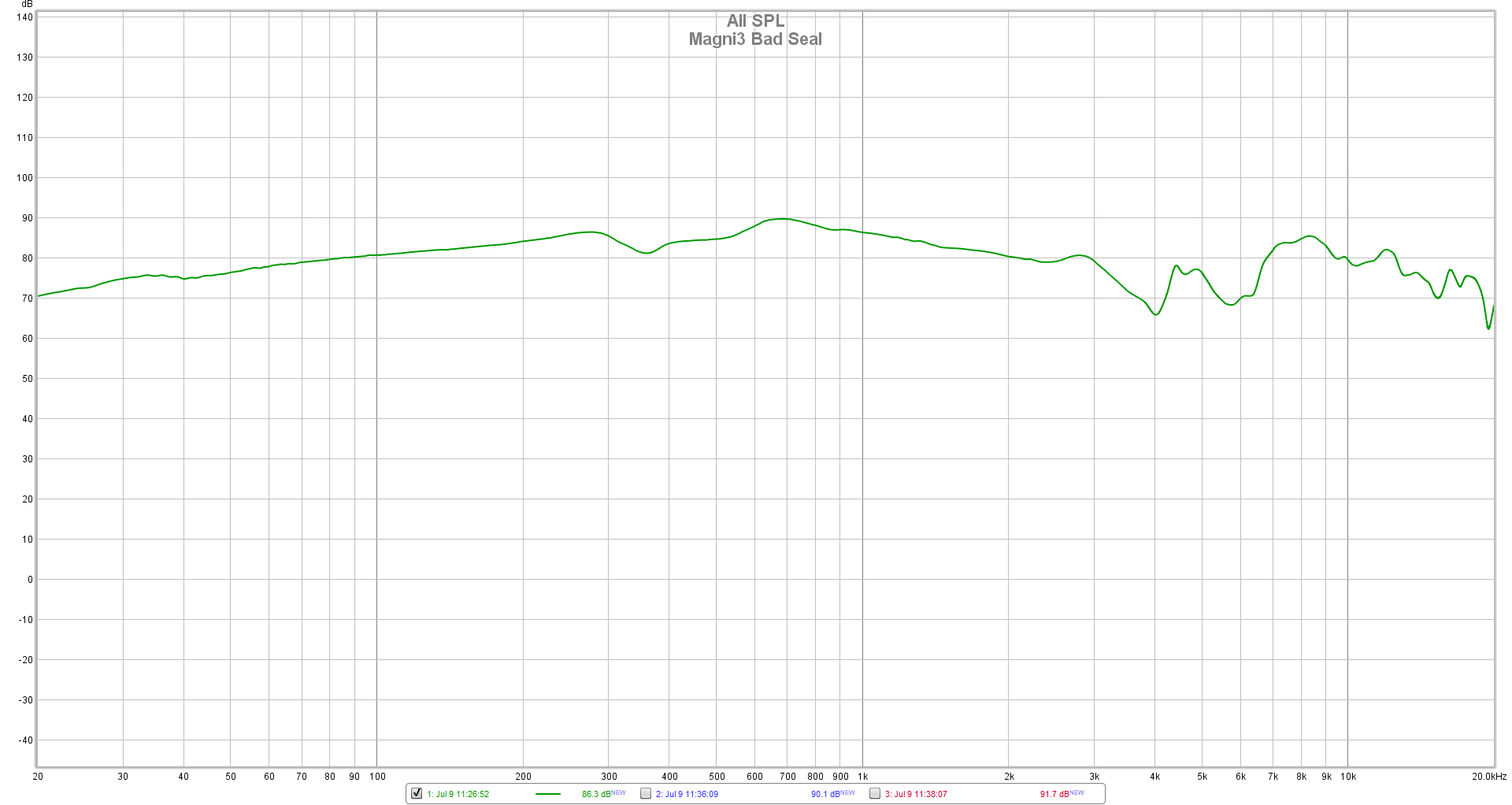
If I am applying a gentle pressure on the earpads, I’m getting a much better reading in terms of FR, much closer to my subjective opinion. This is a raw measurement without any smoothing applied. I’m quite impressed by the driver matching, there is only a very small deviation and only at a specific frequency. Both the Hifiman Arya and Erzetich Phobos had worse driver matching and those two are considerably more expensive.
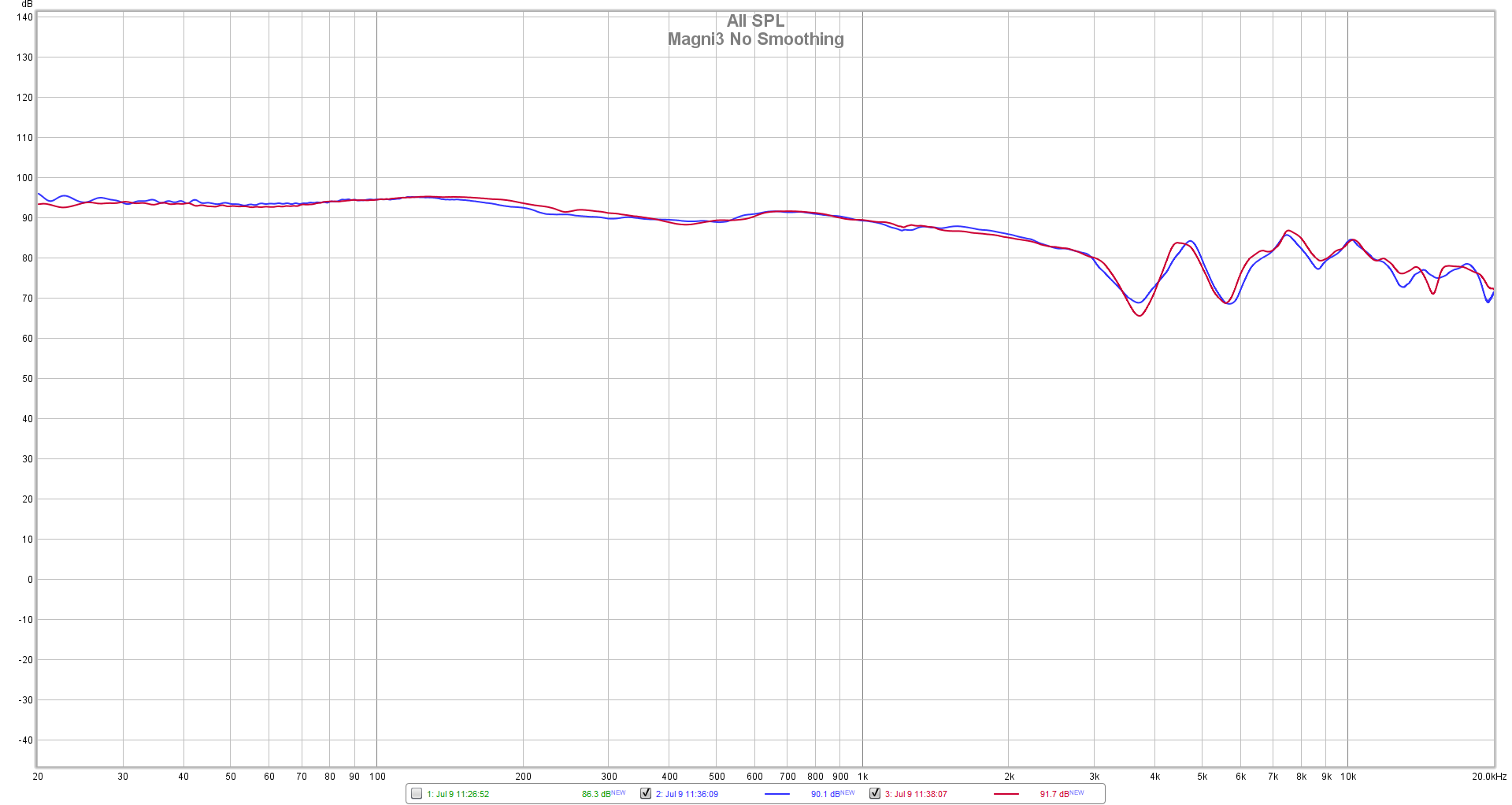
Applying a 1/12 smoothing, I am getting this graph and as you can see from sub-bass up to midrange area, there is a lot of presence in there. A slope in the lower-treble can be observed, more exactly in the 3.5 kHz and 5.5 kHz area, scaring away all the brightness. The rest of the treble fares much better and there is again a slope past 16 kHz making everything sounding more life-like and less sharp and aggressive.
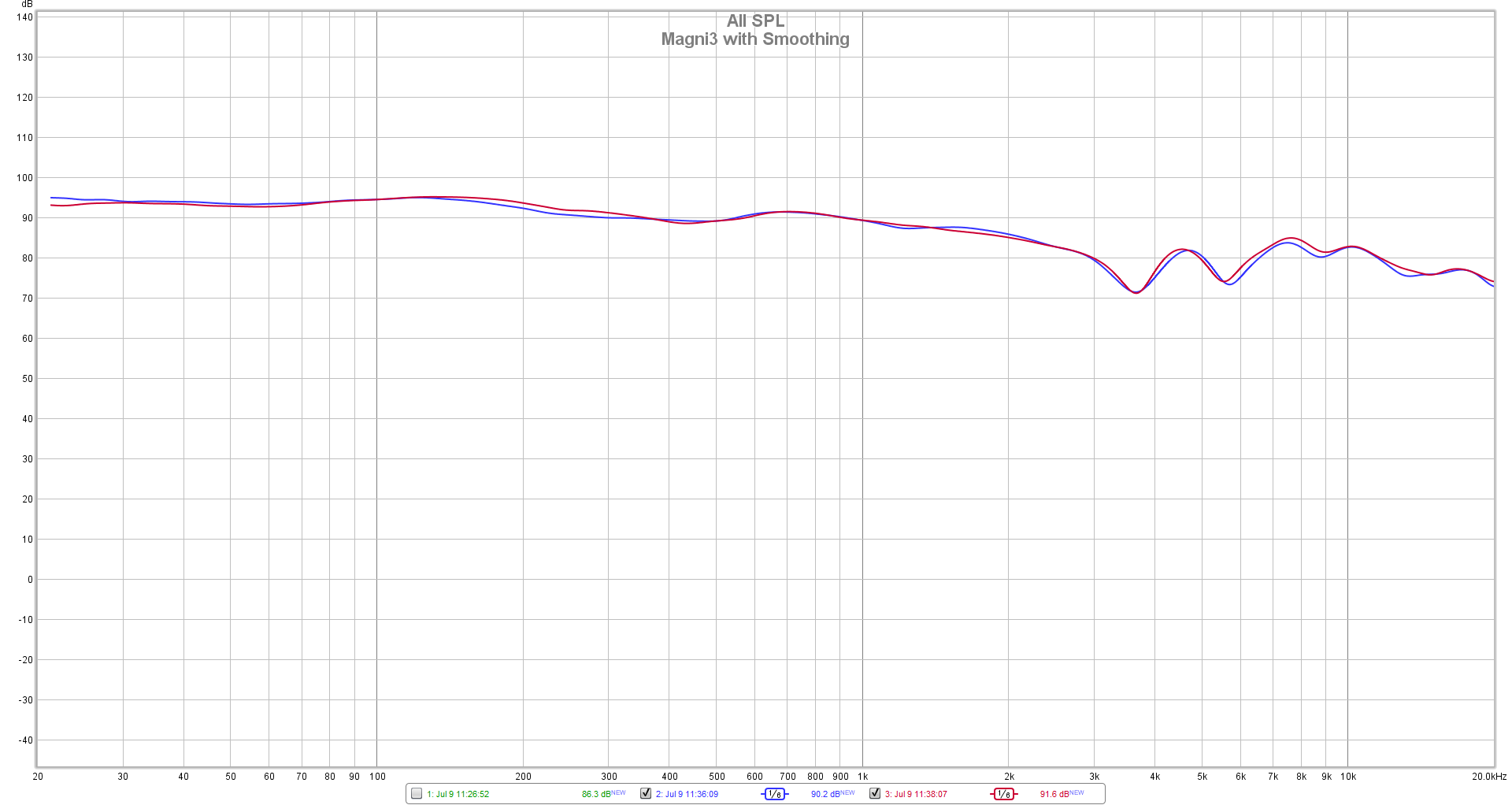
As you can see, Magni was tuned towards a natural and fun experience, in detriment of a super-linear and extended FR. I’m Ok with that, as besides analyzing music, often times I just want to relax and be carried by it.
Considering this is a dynamic driver headphone, I think the THD reading is very good, there is close to zero ringing in the upper FR, which is really nice to see in a closed-back headphone.
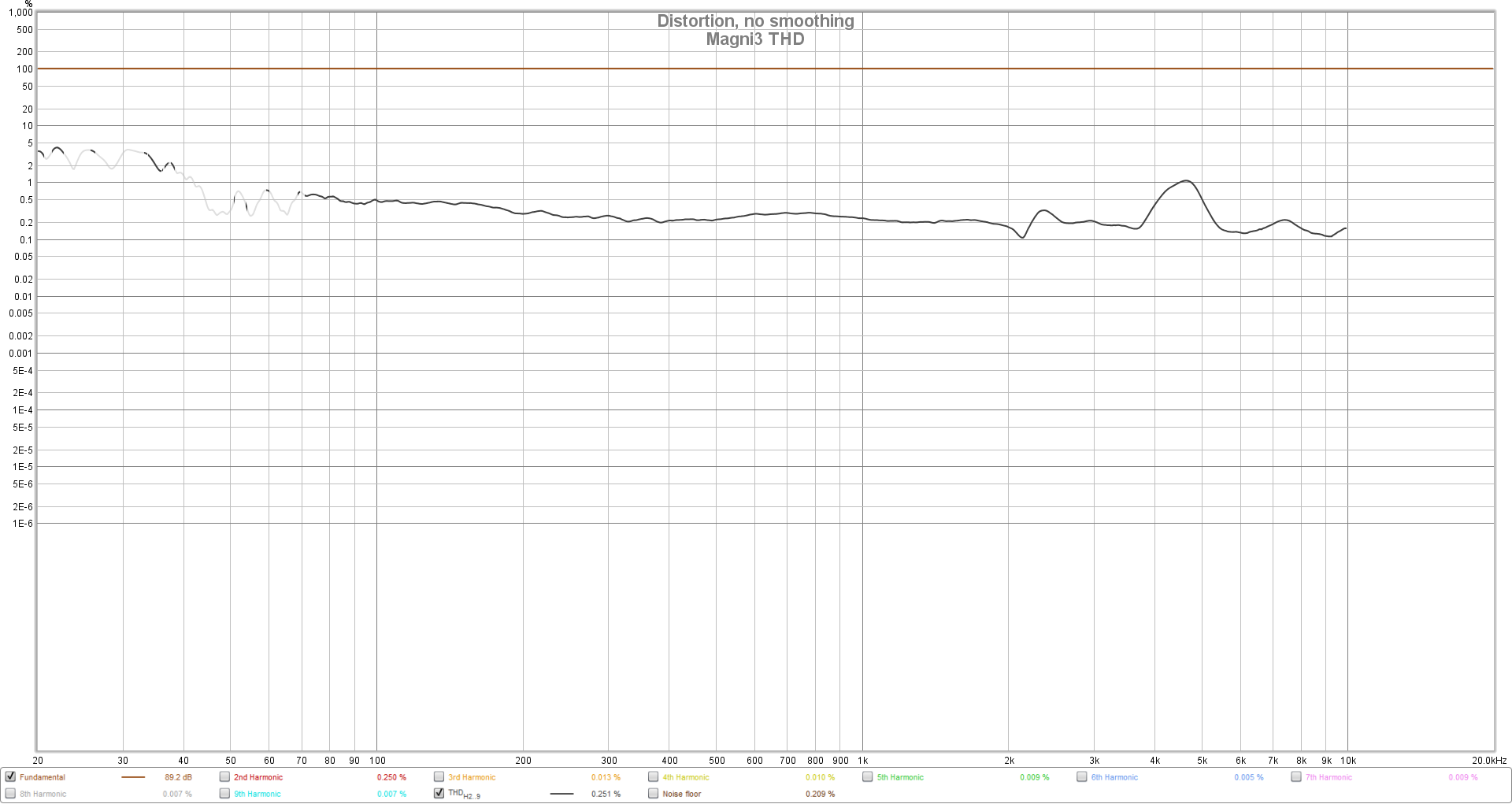
Spectral decay and waterfall reading are not very accurate, because I’m getting a much different picture if I am not applying any pressure on the earpads, but I will just say that even at this point Magni obliterated the spectral decay of another two handcrafted headphones: Erzetich Thalia (€599) and even that of the Phobos (€1999) which is kind of impressive if you ask me.
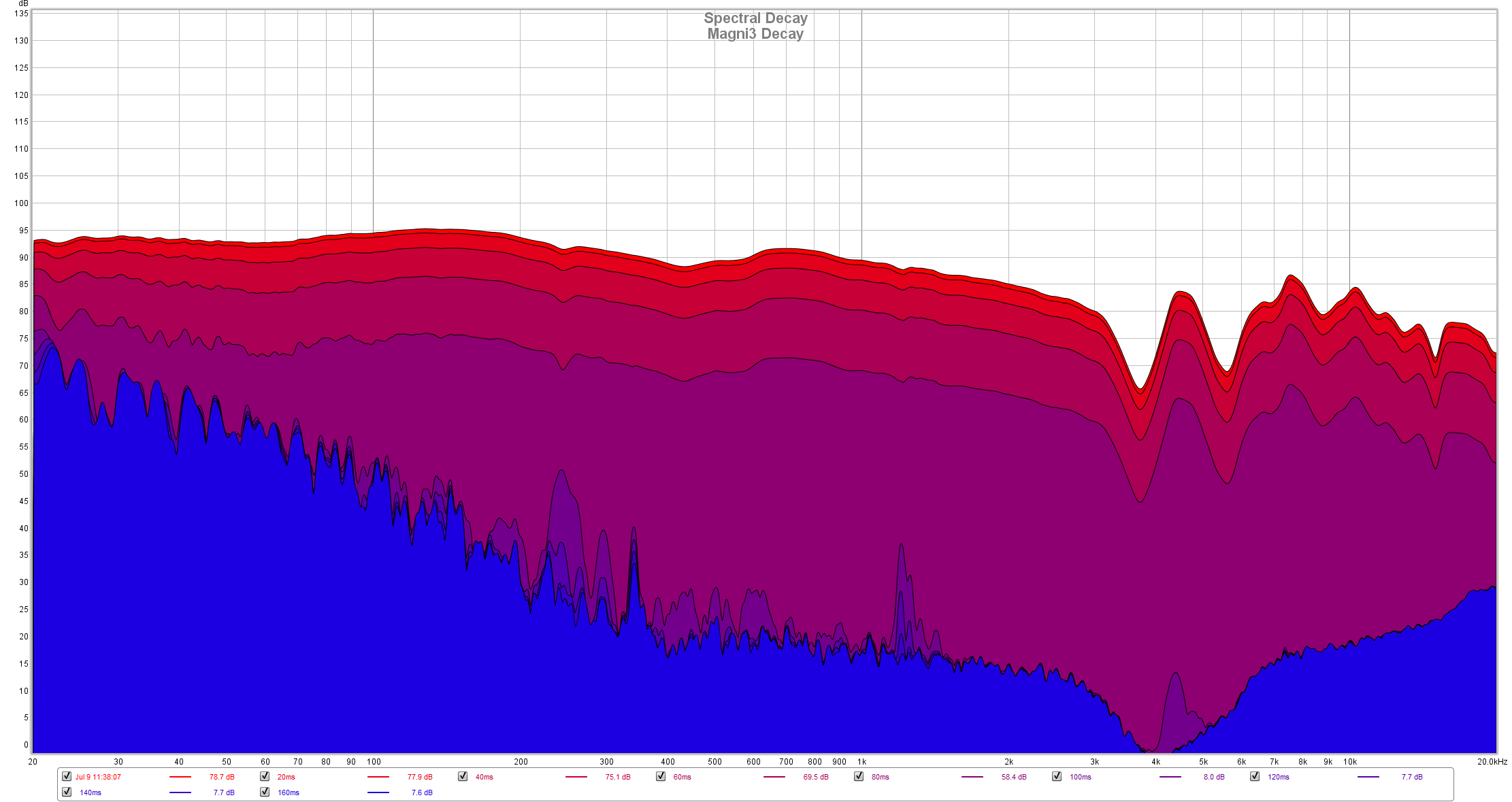
Both the waterfall and spectral decay readings are showing a minimal ringing of the earcups, which is difficult of obtain in a closed-back design.
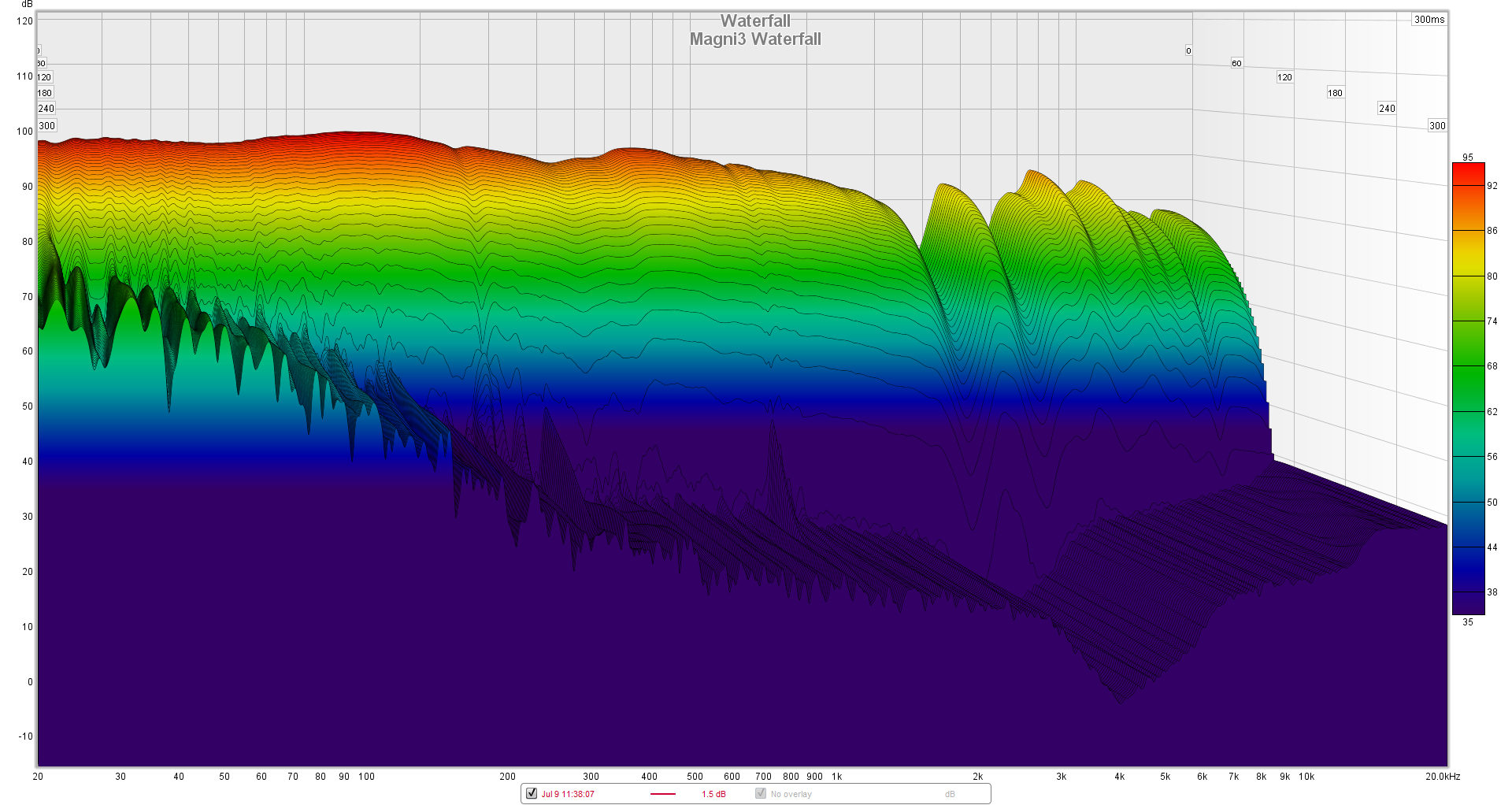
Overall, I recorded a very low THD, an amazing driver matching, a very good spectral decay that proved my point that Magni is indeed a very fast sounding headphone. It has un uneven FR in the treble, but every headphone is doing that and the drops in the 3.5 kHz and 5.5 kHz could be even considered beneficial to some listeners that can’t withstand brightness.
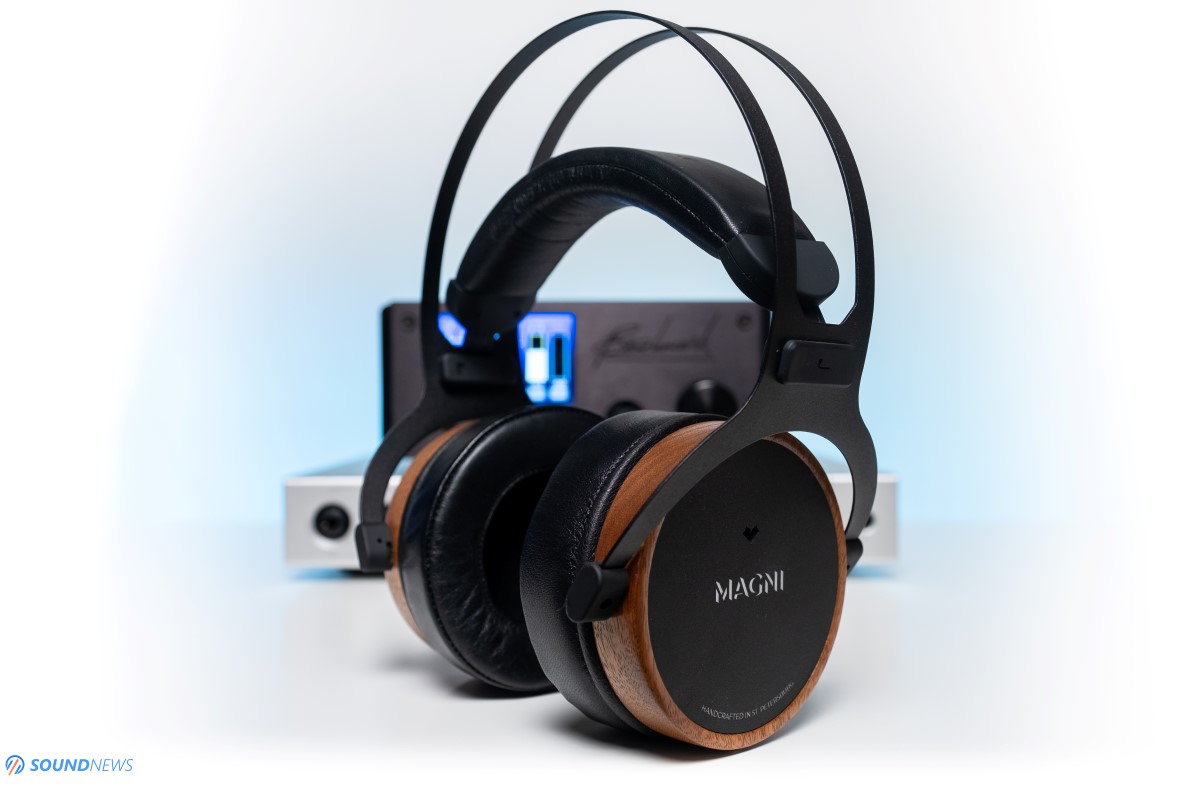
Conclusion
This is my first contact with Kennerton Audio Equipment, but I assure you that it will not be my last. Kennerton Gjallarhorn will be next somewhere next month. I will only say that it will be the first horn-loaded headphone on the market that will forever change the meaning of “soundstage” in a closed-back headphone. Intrigued? You should!
As for Magni, it checks a lot of boxes that I consider very important in a headphone, be it open or closed: it has a high-quality build that should withstand a lot of use and abuse, it has detachable leather ear-pads that will not peel off in few months, it has a thick stock detachable cable with high-quality metal connectors on both ends, it has a beautiful transportable case for your headphones in there too, it has a very high comfort level even after few hours of use and most importantly it delivers a high enjoyment factor and some impressive dynamics as well. It will not challenge the most detailed or the best measuring headphones out there, but it will surely challenge the most fun sounding headphones that I had the pleasure of testing.
Considering this is a closed-back headphone with very few flaws to mention, I’m glad to recommend Kennerton Magni as an outstanding headphone that changed the way I’m looking at closed-back designs.
The best part? Kennerton Magni will cost you only €690 + VAT. Even that Limited Edition with beautiful Zebrano wood cups can be yours for the same amount. You can buy one by following this link and if you are hunting for a deal on them, keep an eye on this page as sometimes a pair of Magni would appear in there too.
PROS:
- Great build quality using only long-lasting materials
- These are handcrafted headphones and you can feel that immediately
- Custom wooden cups are adding a lot of character and uniqueness
- Very comfortable in the long due to an amazing weight distribution and adjustment mechanism
- Good tonal balance, going towards a fun musical experience
- Full-bodied sound, there is warmth and naturalness in this one
- Quite open and wide sounding, considering that it’s a closed-back design
- Accurate pin-point imaging and note placement around the listener
- Great detail retrieval, challenging even pricier headphones
- Dynamics, dynamics, dynamics – they came, they saw, they conquered
- Amazing speed and slam – a transient response monster with the right electronics
- Super easy to drive thanks to a very low sensitivity, headphone amp-less listeners rejoice
- That carry case and those high-quality detachable cables are adding a lot of value to this package and I wish more would put a bigger importance to them
- Very affordable headphones having an incredible value
CONS:
- Treble could be more linear -> lacks ultimate sparkle up-top
ASSOCIATED EQUIPMENT:
- DACs: Audiobyte HydraVox + HydraZap, Musician Pegasus, Flux Lab Acoustics FCN-10, Matrix Audio Element X, Burson Conductor 3X Performance
- Headphone Amps: Benchmark HPA4, SparkoS Labs Aries, Flux Lab Acoustics FCN-10
- Integrated Amps: Hegel H190, KECES E40
- Power Amps: KECES S125, Kinki Studio EX-M7
- IEMs: FiiO FA9, FH7
- Portable headphones: Sennheiser Momentum 2, Meze 99 Classics
- Full-sized headphones: Kennerton Magni, Kennerton Gjallarhorn, Audeze LCD-4, Erzetich Phobos, Hifiman Arya, Quad ERA-1, Ollo S4X Reference
- Loudspeakers: Buchardt S400, KEF LS50W
- Interconnects: QED Reference (x2), Aune AL3
- Speaker cables: Kimber PR8, Audioquest Type4
- Power Cables: Isotek EVO3 Premier (x2)
- Balanced Isolation Power Conditioners: PLiXiR Elite BAC400, KECES BP-600
